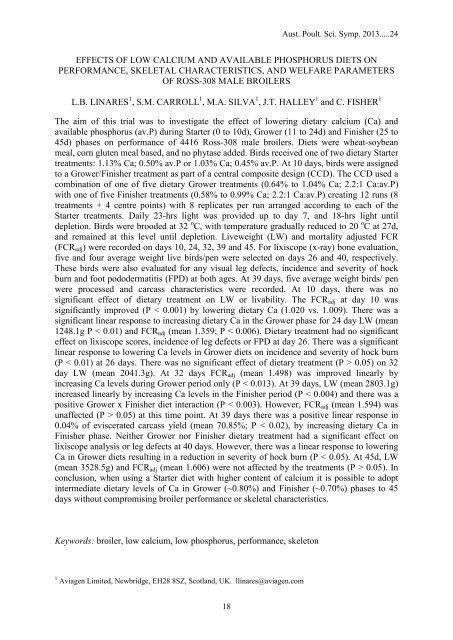APSS 2013 Proceedings - The University of Sydney
APSS 2013 Proceedings - The University of Sydney
APSS 2013 Proceedings - The University of Sydney
You also want an ePaper? Increase the reach of your titles
YUMPU automatically turns print PDFs into web optimized ePapers that Google loves.
Aust. Poult. Sci. Symp. <strong>2013</strong>.....24<br />
EFFECTS OF LOW CALCIUM AND AVAILABLE PHOSPHORUS DIETS ON<br />
PERFORMANCE, SKELETAL CHARACTERISTICS, AND WELFARE PARAMETERS<br />
OF ROSS-308 MALE BROILERS<br />
L.B. LINARES 1 , S.M. CARROLL 1 , M.A. SILVA 1 , J.T. HALLEY 1 and C. FISHER 1<br />
<strong>The</strong> aim <strong>of</strong> this trial was to investigate the effect <strong>of</strong> lowering dietary calcium (Ca) and<br />
available phosphorus (av.P) during Starter (0 to 10d), Grower (11 to 24d) and Finisher (25 to<br />
45d) phases on performance <strong>of</strong> 4416 Ross-308 male broilers. Diets were wheat-soybean<br />
meal, corn gluten meal based, and no phytase added. Birds received one <strong>of</strong> two dietary Starter<br />
treatments: 1.13% Ca; 0.50% av.P or 1.03% Ca; 0.45% av.P. At 10 days, birds were assigned<br />
to a Grower/Finisher treatment as part <strong>of</strong> a central composite design (CCD). <strong>The</strong> CCD used a<br />
combination <strong>of</strong> one <strong>of</strong> five dietary Grower treatments (0.64% to 1.04% Ca; 2.2:1 Ca:av.P)<br />
with one <strong>of</strong> five Finisher treatments (0.58% to 0.99% Ca; 2.2:1 Ca:av.P) creating 12 runs (8<br />
treatments + 4 centre points) with 8 replicates per run arranged according to each <strong>of</strong> the<br />
Starter treatments. Daily 23-hrs light was provided up to day 7, and 18-hrs light until<br />
depletion. Birds were brooded at 32 o C, with temperature gradually reduced to 20 o C at 27d,<br />
and remained at this level until depletion. Liveweight (LW) and mortality adjusted FCR<br />
(FCR adj ) were recorded on days 10, 24, 32, 39 and 45. For lixiscope (x-ray) bone evaluation,<br />
five and four average weight live birds/pen were selected on days 26 and 40, respectively.<br />
<strong>The</strong>se birds were also evaluated for any visual leg defects, incidence and severity <strong>of</strong> hock<br />
burn and foot pododermatitis (FPD) at both ages. At 39 days, five average weight birds/ pen<br />
were processed and carcass characteristics were recorded. At 10 days, there was no<br />
significant effect <strong>of</strong> dietary treatment on LW or livability. <strong>The</strong> FCR adj at day 10 was<br />
significantly improved (P < 0.001) by lowering dietary Ca (1.020 vs. 1.009). <strong>The</strong>re was a<br />
significant linear response to increasing dietary Ca in the Grower phase for 24 day LW (mean<br />
1248.1g P < 0.01) and FCR adj (mean 1.359; P < 0.006). Dietary treatment had no significant<br />
effect on lixiscope scores, incidence <strong>of</strong> leg defects or FPD at day 26. <strong>The</strong>re was a significant<br />
linear response to lowering Ca levels in Grower diets on incidence and severity <strong>of</strong> hock burn<br />
(P < 0.01) at 26 days. <strong>The</strong>re was no significant effect <strong>of</strong> dietary treatment (P > 0.05) on 32<br />
day LW (mean 2041.3g). At 32 days FCR adj (mean 1.498) was improved linearly by<br />
increasing Ca levels during Grower period only (P < 0.013). At 39 days, LW (mean 2803.1g)<br />
increased linearly by increasing Ca levels in the Finisher period (P < 0.004) and there was a<br />
positive Grower x Finisher diet interaction (P < 0.003). However, FCR adj (mean 1.594) was<br />
unaffected (P > 0.05) at this time point. At 39 days there was a positive linear response in<br />
0.04% <strong>of</strong> eviscerated carcass yield (mean 70.85%; P < 0.02), by increasing dietary Ca in<br />
Finisher phase. Neither Grower nor Finisher dietary treatment had a significant effect on<br />
lixiscope analysis or leg defects at 40 days. However, there was a linear response to lowering<br />
Ca in Grower diets resulting in a reduction in severity <strong>of</strong> hock burn (P < 0.05). At 45d, LW<br />
(mean 3528.5g) and FCR adj (mean 1.606) were not affected by the treatments (P > 0.05). In<br />
conclusion, when using a Starter diet with higher content <strong>of</strong> calcium it is possible to adopt<br />
intermediate dietary levels <strong>of</strong> Ca in Grower (~0.80%) and Finisher (~0.70%) phases to 45<br />
days without compromising broiler performance or skeletal characteristics.<br />
Keywords: broiler, low calcium, low phosphorus, performance, skeleton<br />
1 Aviagen Limited, Newbridge, EH28 8SZ, Scotland, UK. llinares@aviagen.com<br />
18
















